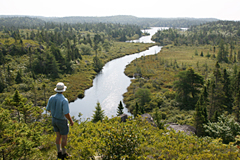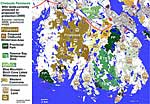The Chebucto Peninsula & the Five Bridge Lakes Wilderness Area (FBLWA)
The Woodens River Watershed is embedded in a larger landscape, the Chebucto Peninsula. The lands of the Chebucto Peninsula comprise a meaningful biogeographical unit by virtue of their common geology and vegetation, high density of lakes, streams and wetlands, proximity to the ocean,  and their largely rural character. (The Chebucto Peninsula includes all land south of Hammonds Plains Road, and bounded on the east, south and west by the Atlantic Ocean; Halifax is sometimes considered to be a subpeninsula of the Chebucto Peninsula.)
We are fortunate that there are now large areas of the Chebucto Peninsula that are protected from development in some way or another. These include
and their largely rural character. (The Chebucto Peninsula includes all land south of Hammonds Plains Road, and bounded on the east, south and west by the Atlantic Ocean; Halifax is sometimes considered to be a subpeninsula of the Chebucto Peninsula.)
We are fortunate that there are now large areas of the Chebucto Peninsula that are protected from development in some way or another. These include
- Provincial Parks:
- Long Lake Provincial Park
- Crystal Crescent Beach Provincial Park
- Lewis Lake Provincial Park
- Peggy's Cove Preservation Area
- Protected Wilderness Areas:
- Terence Bay Wilderness area (designated along with 30 other areas under the Wilderness Areas Protection Act in 1998);
- Blue Mountain-Birch Cove Lakes (declared April 21, 2009)
- Five Bridge Lakes Wilderness Area, declared Oct. 25, 2012, encompasses the entire Bluff Trial, one headwater lake, and parts of several other lakes in the Woodens River Watershed.)
- Nova Scotia Nature Trust:
- Purcell's Cove Conservation Lands
- Purcell's Cove Conservation Lands
- Nature Reserve:
- Duncan's Cove
There remain large blocks of land belonging to the Province as crown land or to HRM. The HRM lands known as the Western Commons (in the region of Ragged Lake) are currently under active consideration for a regional park with a Protected Wilderness Area by the HRM Western Common Wilderness Advisory Committee (WCWAC). Residents on Halifax mainland south are seeking more protection for the Purcell's Backlands.

Hiistory of the FBLWA
In 2001, the Five Bridges Wilderness Heritage Trust was formed with the explicit purpose "to conserve public lands in the area bounded by Highways 103 and 333 on the Chebucto Peninsula in its natural state for public use." (Click on the map at left for a larger version of the map illustrating existing and proposed protected lands, as well as wildlife corridors.)
In the spring of 2008, WRWEO and The Trust, in consort with the St. Margaret's Bay Stewardship Association, the BLT Rails to Trails Association, the Safety Minded ATV Club, the Resource Opportunities Centre, and other community organizations around the Chebucto Peninsula, formed the Chebucto Wilderness Coalition (CWC) to protect these lands - known traditionally as the Five Bridge Lake Wilderness Area (FBLWA) under the Wilderness Areas Protection Act. Their effortsprogressed quickly.
On October 19th, 2009, the Nova Scotia government declared the Five Bridge Lake Wilderness Area a Candidate Wilderness Area. On Oct. 25, 2012, after a year of public consultations, the area was formally designated under the Wilderness Protection Act.
In February 0f 2013, the FBLWA Stewardship Coalition was formed to work with Nova Scotia Environment to share plan, initiate, prioritize, fund, implement, and coordinate projects in the newly protected Five Bridge Lakes Wilderness Area.
A Truly Significant Conservation AreaThe FBLWA is the largest block of land protected from development on the Chebucto Peninsula. It is well established in conservation science that larger areas can support and conserve more species over time than small areas. Just as important, the FBLWA occupies a large area in the centre of the peninsula and it will require relatively small steps to construct conservation corridors connecting the different blocks of protected land on the Chebucto Peninsula. That's what's needed now. Corridors would increase the species carrying capacity of all of the protected blocks of land and, collectively, constitute a very significant conservation area.
Amongst the Challenges: Moose Conservation & Corridor Protection
In the pages following on Moose & Corridors, we discuss reasons why we think moose conservation and corridor protection should now be a priority.
Residential and commercial lands can also contribute to biodiversity conservation
Of course even once the area is finally designated and corridors are (hopefully) firmed up, that is not the end of the story: a major effort will still be needed to promote sustainable and biodiversity-friendly use of commercial and residential lands on the Chebucto Peninsula.
